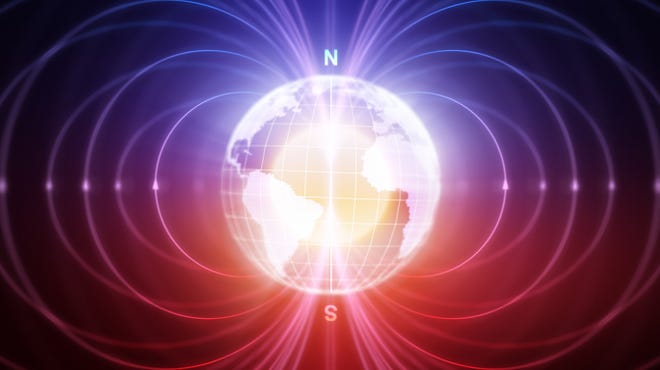Fact check: A compass is oriented to the Earth’s magnetic field lines, doesn’t prove flat earth
The claim: A compass wouldn’t work if Earth is spherical
Earth is surrounded by a magnetic field generated by electric currents from within the planet. Compasses take advantage of this field to identify north and serve as a navigational aid.
But one social media user asserts this effect shouldn’t work on a spherical planet, attempting to bolster the long-debunked theory that the Earth is flat.
“A compass will never work on a Spinning Ball,” reads a Feb. 17 Facebook post. The post includes a video, viewed more than 3,500 times in four days.
However, the post demonstrates a misunderstanding of the way compasses function, according to experts.
Follow us on Facebook! Like our page to get updates throughout the day on our latest debunks
The Facebook user who shared the video could not be reached.
A compass orients along Earth’s magnetic field lines
The Earth’s magnetic field has poles – north and south. These poles move, but are located relatively near the geographic north and south poles – the poles typically shown on maps.
A compass is able to point toward magnetic north because it contains a magnet that orients itself along the magnetic field lines that extend between the north and south magnetic poles, looping out from the earth as they circle the globe and connect to the opposite pole.

Because the current locations of both magnetic and geographic north are known, a simple adjustment allows the user to orient themselves to geographic north so they can effectively use a map.
To operate correctly, a compass must be held relatively parallel to the surface of the Earth, to align the needle with the magnetic fields.
The video in the social media post argues that a line drawn parallel to the spherical plane of the Earth in, for instance, Brazil, cannot point at the geographic location of magnetic north – in the Arctic – without cutting through the Earth itself.
This is accurate.
In Brazil, a compass needle pointing toward the actual geographic location of magnetic north would have to point somewhat downwards into the Earth. It would not appear parallel to the surface at that location and it would not be very helpful for navigation in that area.
But this illustration reflects a misunderstanding of the basic mechanics of a compass. The needle isn’t pointing to the north pole itself, it’s aligning with the magnetic field lines that run to the magnetic north pole.
“The compass needle points in the direction of the magnetic field at its location, not at the direction where the magnetic pole is located on the surface,” Rona Oran, a computational space physicist at Massachusetts Institute of Technology, told USA TODAY in an email.
This is why the needle can point north and remain parallel to the surface from the user’s perspective.
Fact check: WikiLeaks did not release footage that proves moon landing staged
USA TODAY has debunked other false claims about planetary science. For instance, social media users falsely claimed that clouds appearing to go behind the sun prove the earth is flat, and that the rupture of a soda can in a vacuum proved that gas planets can’t exist.
Our rating: False
Based on our research, we rate FALSE the claim that a compass wouldn’t work if Earth is spherical. Compasses orient themselves to the Earth’s magnetic field lines. The needle does not point at the actual geographical location of magnetic north.
Our fact-check sources:
- Rona Oran, Feb. 17, Email exchange with USA TODAY
- Benjamin Weiss, Feb. 17, Email exchange with USA TODAY
- NASA, Dec. 5, 2011, Representation of the Earth’s Magnetic Field
- NOAA, Jan. 1, 2010, Earth’s Magnetic Lines
- USA TODAY, Jan. 28, Fact check: Soda experiment does not disprove existence of gas planets
- Scientific American, Mar. 27, 2020, Flat Earthers: What They Believe and Why
- Live Science, Mar. 6, 2019, Earth’s Magnetic Field and Wandering Poles
- NOAA, accessed Feb. 21, Wandering of the Geomagnetic poles
- USA TODAY, Jan. 23, Fact check: Clouds can appear behind the sun in photos due to optical illusion
Thank you for supporting our journalism. You can subscribe to our print edition, ad-free app or electronic newspaper replica here.
Our fact-check work is supported in part by a grant from Facebook.



